Abstract
1 Four equal-sexed groups of eight normal subjects were given single doses of either (±)-propranolol (120 mg), (+)-propranolol (120 mg), diazepam (6 mg) or placebo using double-blind procedure and their effects studied under three types of experimental stress and at rest.
2 Finger tremor, EEG, averaged auditory evoked response, skin conductance, heart rate and respiratory rate were measured at each time of testing, and subjects also completed performance tests (reaction time, tapping speed and symbol copying) and subjective mood scales.
3 Neither (+)- nor (±)-propranolol had any beneficial effects on mood and physiological tests showed that, although adequate β-adrenoceptor blockade was achieved, there was no evidence of sedation.
4 Diazepam reduced subjective anxiety, significantly lessened the main amplitude of the auditory evoked response and also reduced the proportion of slower rhythms in the EEG.
5 The results suggest that (+)- and (±)-propranolol have no psychotropic effects on induced anxiety and that their modes of action are fundamentally different from that of diazepam.
Full text
PDF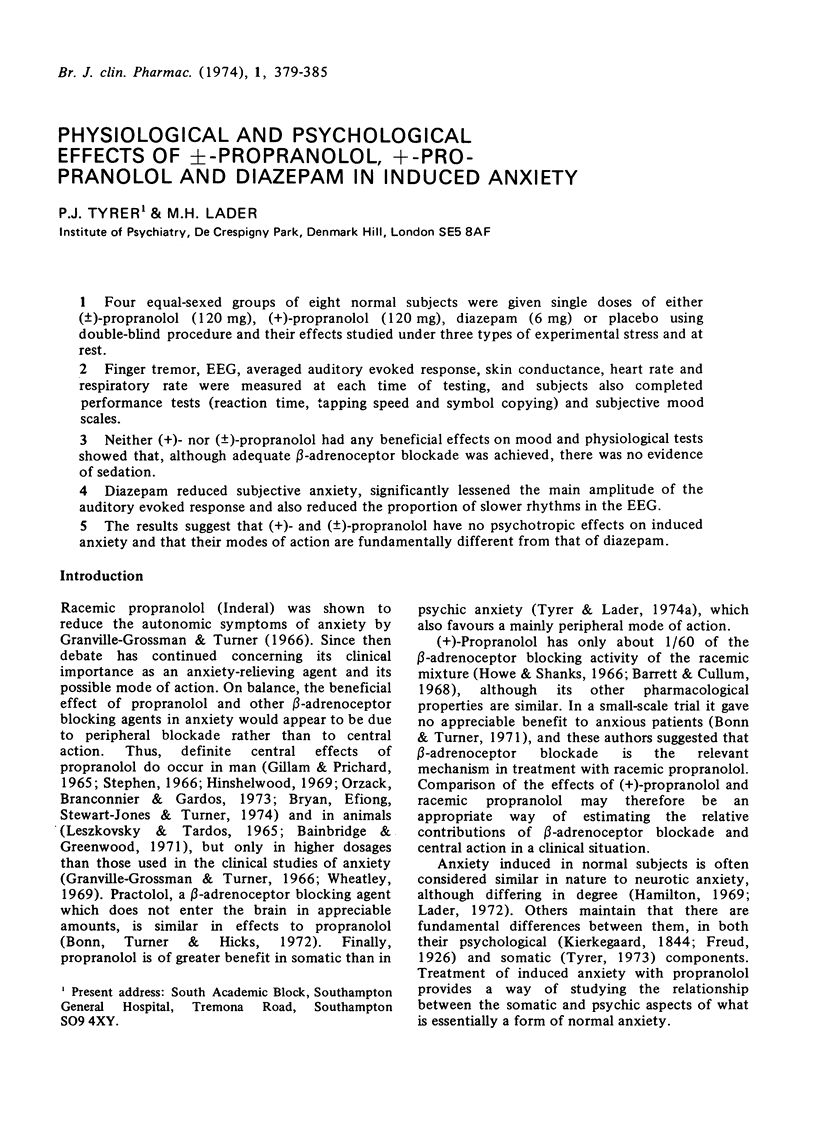
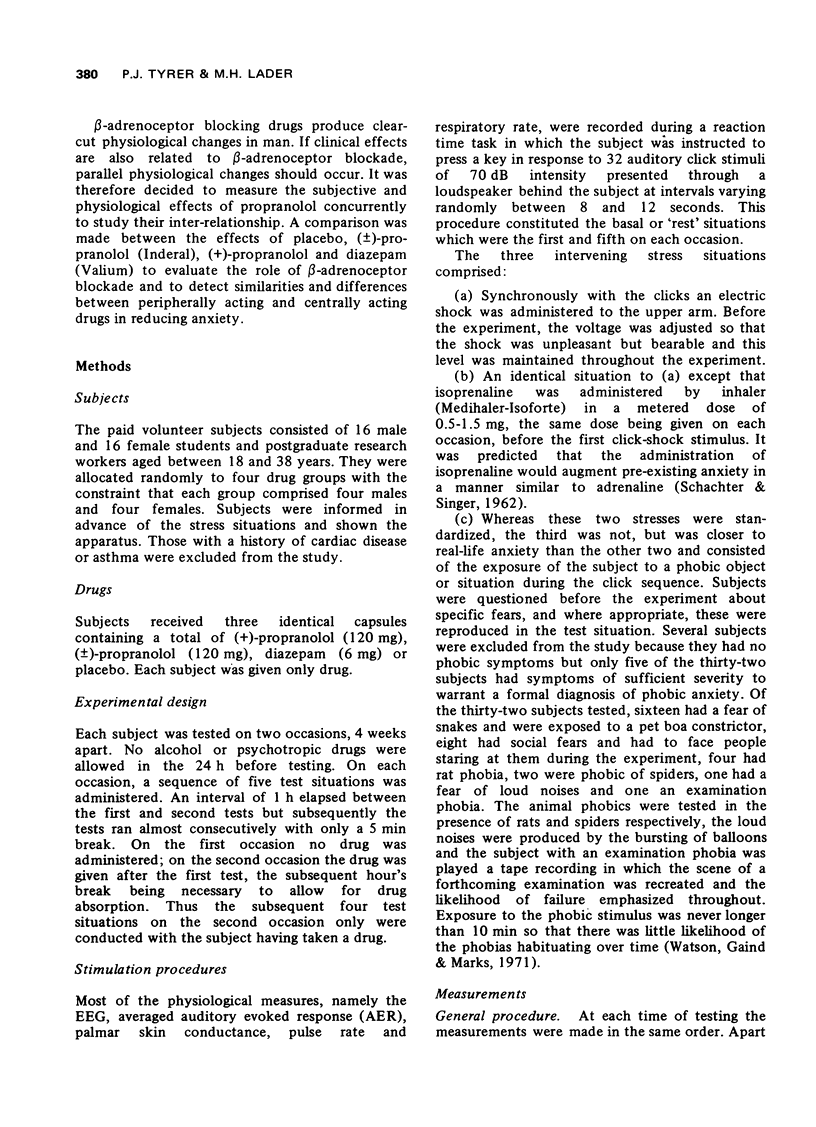
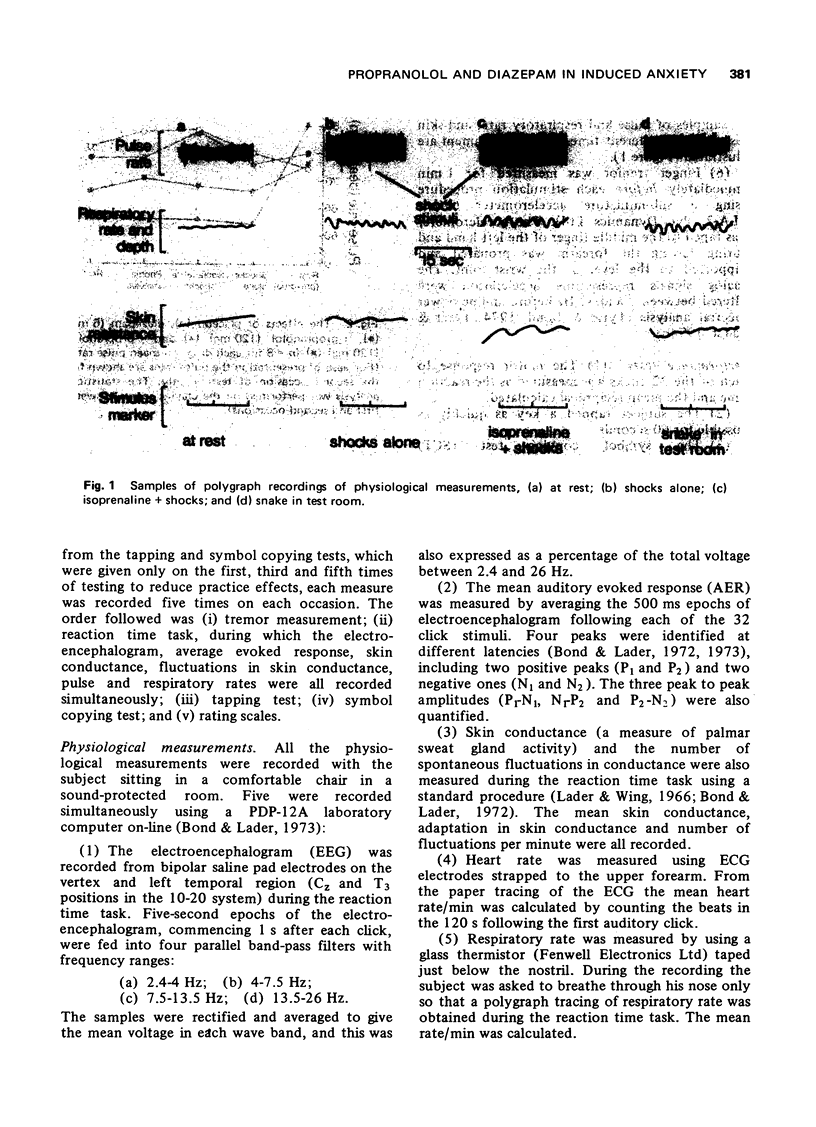
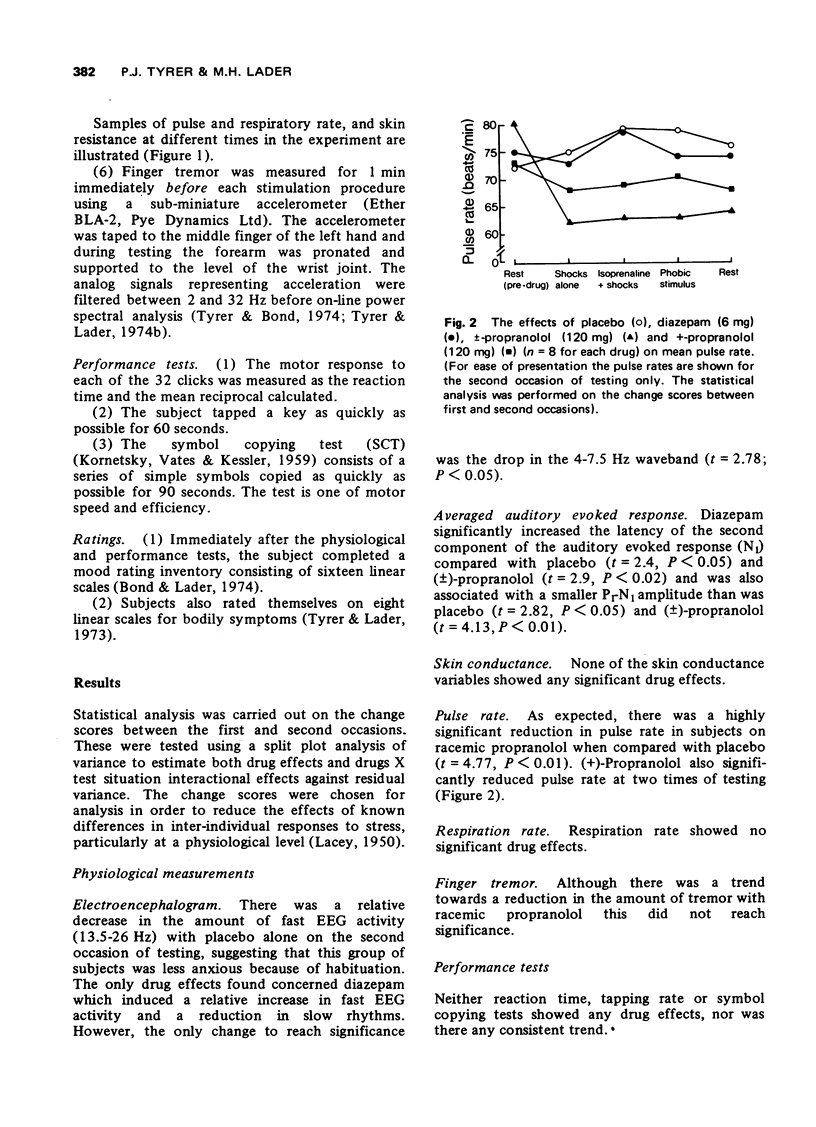
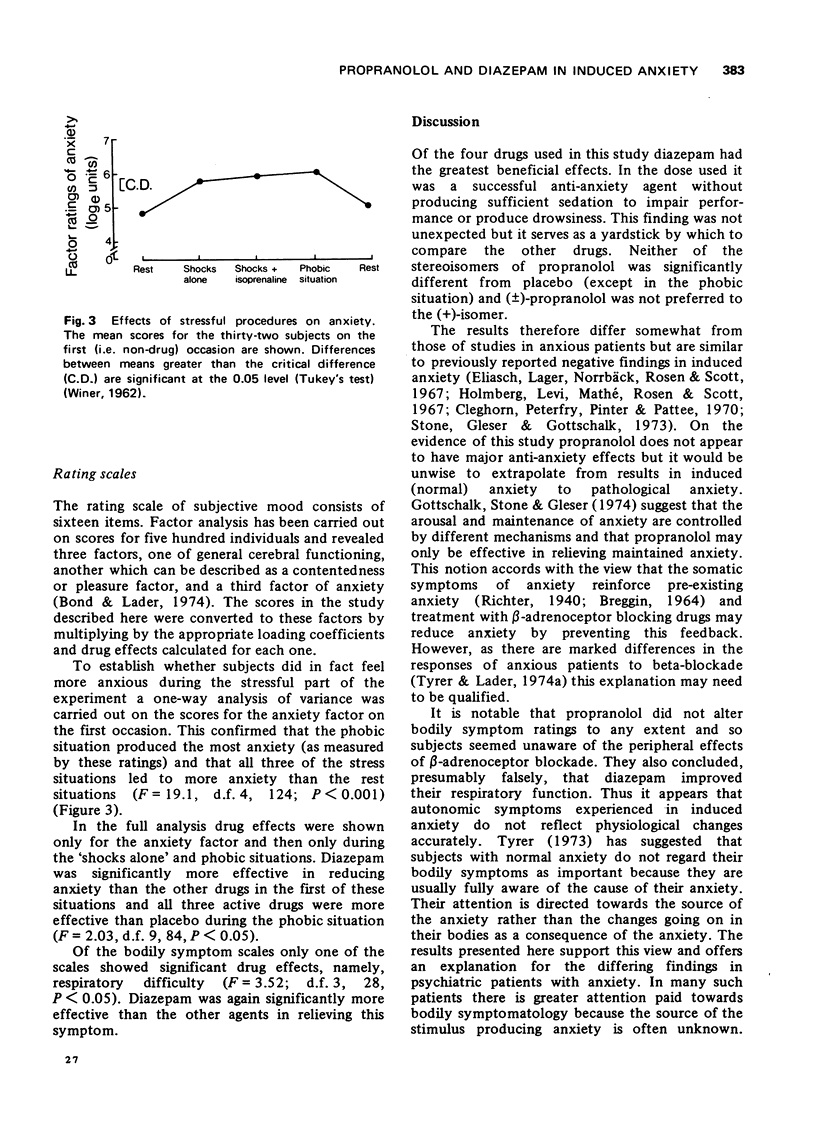
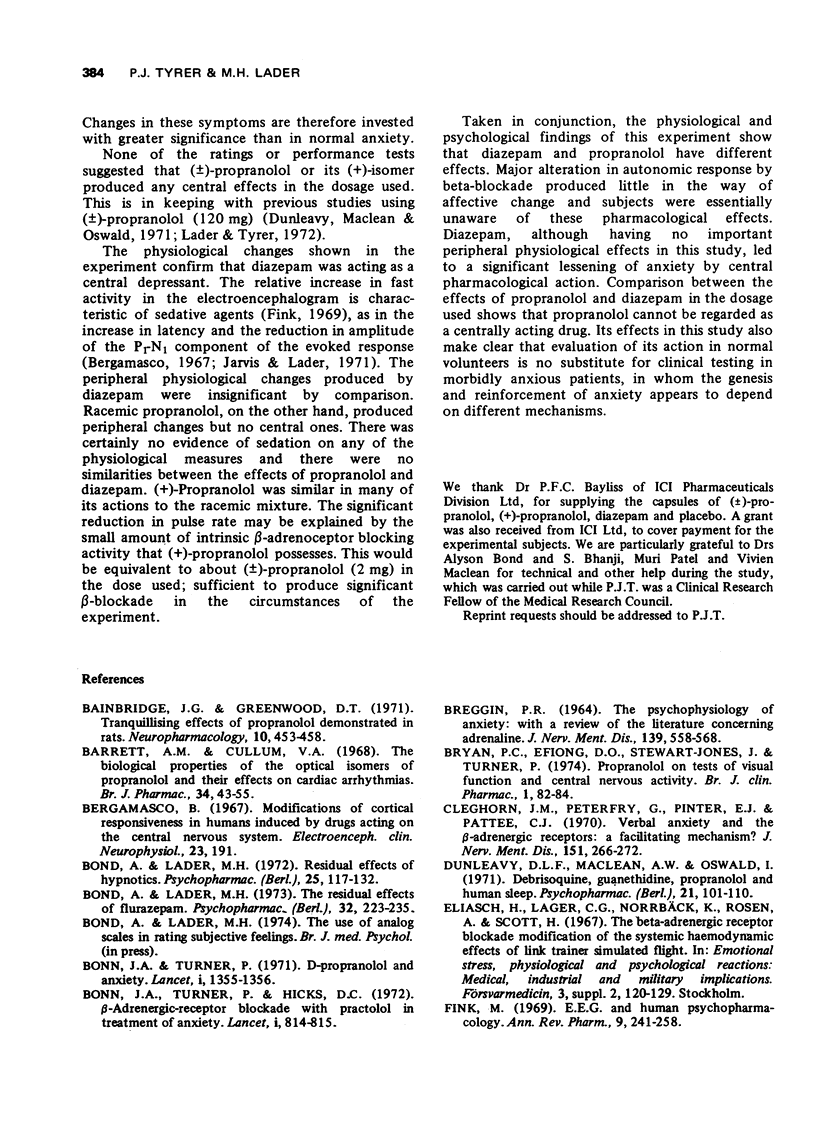
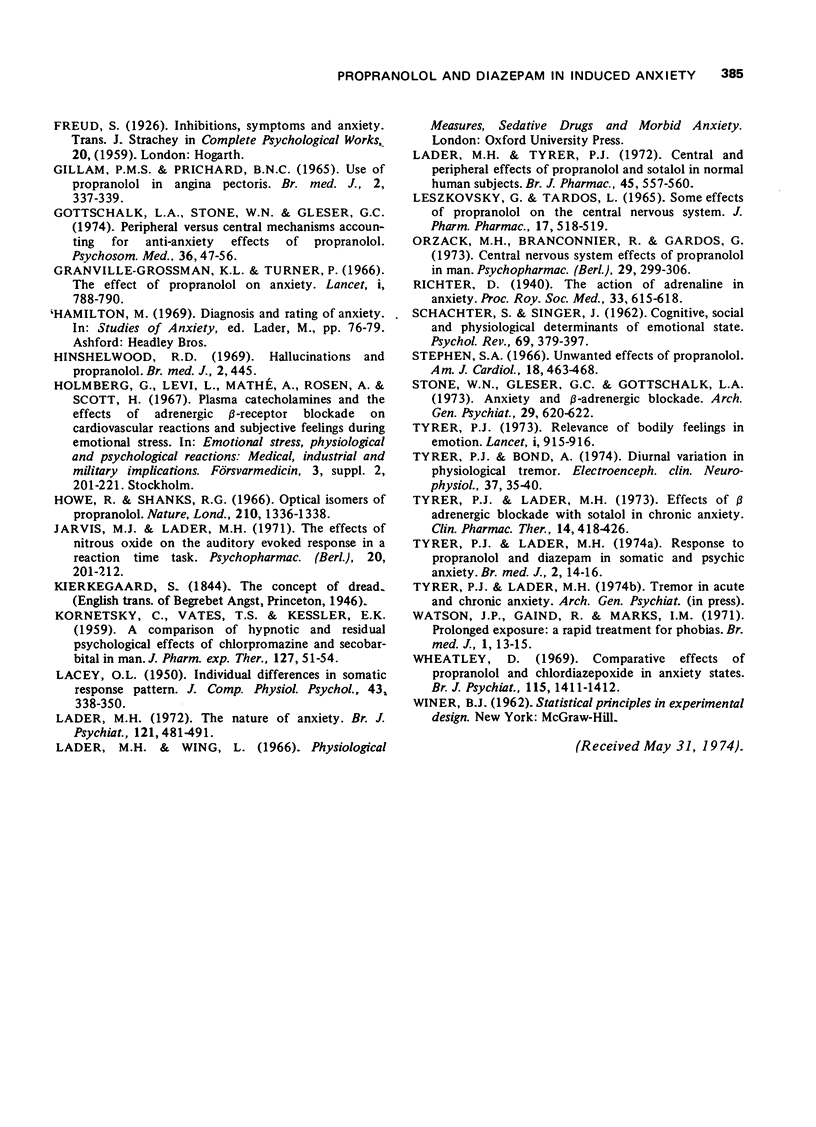
Selected References
These references are in PubMed. This may not be the complete list of references from this article.
- Bainbridge J. G., Greenwood D. T. Tranquillizing effects of propranolol demonstrated in rats. Neuropharmacology. 1971 Jul;10(4):453–458. doi: 10.1016/0028-3908(71)90073-6. [DOI] [PubMed] [Google Scholar]
- Bergamasco B. Modifications of cortical responsiveness in humans induced by drugs acting on the central nervous system. Electroencephalogr Clin Neurophysiol. 1967 Aug;23(2):191–191. [PubMed] [Google Scholar]
- Bond A. J., Lader M. H. Residual effects of hypnotics. Psychopharmacologia. 1972;25(2):117–132. doi: 10.1007/BF00423189. [DOI] [PubMed] [Google Scholar]
- Bond A. J., Lader M. H. The residual effects of flurazepam. Psychopharmacologia. 1973 Sep 28;32(3):223–235. doi: 10.1007/BF00422145. [DOI] [PubMed] [Google Scholar]
- Bonn J. A., Turner P. D-Propranolol and anxiety. Lancet. 1971 Jun 26;1(7713):1355–1356. doi: 10.1016/s0140-6736(71)91915-5. [DOI] [PubMed] [Google Scholar]
- Bonn J. A., Turner P., Hicks D. C. Beta-adrenergic-receptor blockade with practolol in treatment of anxiety. Lancet. 1972 Apr 15;1(7755):814–815. doi: 10.1016/s0140-6736(72)90799-4. [DOI] [PubMed] [Google Scholar]
- Cleghorn J. M., Peterfy G., Pinter E. J., Pattee C. J. Verbal anxiety and the beta adrenergic receptors: a facilitating mechanism? J Nerv Ment Dis. 1970 Oct;151(4):266–272. doi: 10.1097/00005053-197010000-00003. [DOI] [PubMed] [Google Scholar]
- Dunleavy D. L., MacLean A. W., Oswald I. Debrisoquine, guanethidine, propranolol and human sleep. Psychopharmacologia. 1971;21(2):101–110. doi: 10.1007/BF00572267. [DOI] [PubMed] [Google Scholar]
- Fink M. EEG and human psychopharmacology. Annu Rev Pharmacol. 1969;9:241–258. doi: 10.1146/annurev.pa.09.040169.001325. [DOI] [PubMed] [Google Scholar]
- GILLAM P. M., PRICHARD B. N. USE OF PROPRANOLOL IN ANGINA PECTORIS. Br Med J. 1965 Aug 7;2(5457):337–339. doi: 10.1136/bmj.2.5457.337. [DOI] [PMC free article] [PubMed] [Google Scholar]
- Gottschalk L. A., Stone W. N., Gleser G. C. Peripheral versus central mechanisms accounting for antianxiety effects of propranolol. Psychosom Med. 1974 Jan-Feb;36(1):47–56. doi: 10.1097/00006842-197401000-00004. [DOI] [PubMed] [Google Scholar]
- Granville-Grossman K. L., Turner P. The effect of propranolol on anxiety. Lancet. 1966 Apr 9;1(7441):788–790. doi: 10.1016/s0140-6736(66)91863-0. [DOI] [PubMed] [Google Scholar]
- Hinshelwood R. D. Hallucinations and propranolol. Br Med J. 1969 May 17;2(5654):445–445. doi: 10.1136/bmj.2.5654.445. [DOI] [PMC free article] [PubMed] [Google Scholar]
- Howe R., Shanks R. G. Optical isomers of propranolol. Nature. 1966 Jun 25;210(5043):1336–1338. doi: 10.1038/2101336a0. [DOI] [PubMed] [Google Scholar]
- Jarvis M. J., Lader M. H. The effects of nitrous oxide on the auditory evoked response in a reaction time task. Psychopharmacologia. 1971;20(3):201–212. doi: 10.1007/BF00402097. [DOI] [PubMed] [Google Scholar]
- KORNETSKY C., VATES T. S., KESSLER E. K. A comparison of hypnotic and residual psychological effects of single doses of chlorpromazine and secobarbital in man. J Pharmacol Exp Ther. 1959 Sep;127:51–54. [PubMed] [Google Scholar]
- LACEY J. I. Individual differences in somatic response patterns. J Comp Physiol Psychol. 1950 Oct;43(5):338–350. doi: 10.1037/h0057436. [DOI] [PubMed] [Google Scholar]
- Lader M. H., Tyrer P. J. Central and peripheral effects of propranolol and sotalol in normal human subjects. Br J Pharmacol. 1972 Jul;45(3):557–560. doi: 10.1111/j.1476-5381.1972.tb08113.x. [DOI] [PMC free article] [PubMed] [Google Scholar]
- Leszkovszky G., Tardos L. Some effects of propranolol on the central nervous system. J Pharm Pharmacol. 1965 Aug;17(8):518–519. doi: 10.1111/j.2042-7158.1965.tb07715.x. [DOI] [PubMed] [Google Scholar]
- Orzack M. H., Branconnier R., Gardos G. CNS effects of propranolol in man. Psychopharmacologia. 1973;29(4):299–306. doi: 10.1007/BF00429277. [DOI] [PubMed] [Google Scholar]
- Richter D. The Action of Adrenaline in Anxiety: (Section of Psychiatry). Proc R Soc Med. 1940 Aug;33(10):615–618. [PMC free article] [PubMed] [Google Scholar]
- SCHACHTER S., SINGER J. E. Cognitive, social, and physiological determinants of emotional state. Psychol Rev. 1962 Sep;69:379–399. doi: 10.1037/h0046234. [DOI] [PubMed] [Google Scholar]
- Stephen S. A. Unwanted effects of propranolol. Am J Cardiol. 1966 Sep;18(3):463–472. doi: 10.1016/0002-9149(66)90071-3. [DOI] [PubMed] [Google Scholar]
- Stone W. N., Gleser G. C., Gottschalk L. A. Anxiety and beta-adrenergic blockade. Arch Gen Psychiatry. 1973 Nov;29(5):620–622. doi: 10.1001/archpsyc.1973.04200050033005. [DOI] [PubMed] [Google Scholar]
- Tyrer P. J., Lader M. H. Effects of beta adrenergic blockade with sotalol in chronic anxiety. Clin Pharmacol Ther. 1973 May-Jun;14(3):418–426. doi: 10.1002/cpt1973143418. [DOI] [PubMed] [Google Scholar]
- Tyrer P. J., Lader M. H. Response to propranolol and diazepam in somatic and psychic anxiety. Br Med J. 1974 Apr 6;2(5909):14–16. doi: 10.1136/bmj.2.5909.14. [DOI] [PMC free article] [PubMed] [Google Scholar]
- Tyrer P. J. Relevance of bodily feelings in emotion. Lancet. 1973 Apr 28;1(7809):915–916. doi: 10.1016/s0140-6736(73)91365-2. [DOI] [PubMed] [Google Scholar]
- Watson J. P., Gaind R., Marks I. M. Prolonged exposure: a rapid treatment for phobias. Br Med J. 1971 Jan 2;1(5739):13–15. doi: 10.1136/bmj.1.5739.13. [DOI] [PMC free article] [PubMed] [Google Scholar]
- Wheatley D. Comparative effects of propranolol and chlordiazepoxide in anxiety states. Br J Psychiatry. 1969 Dec;115(529):1411–1412. doi: 10.1192/bjp.115.529.1411. [DOI] [PubMed] [Google Scholar]


